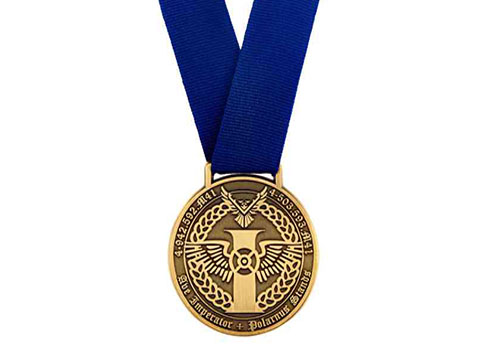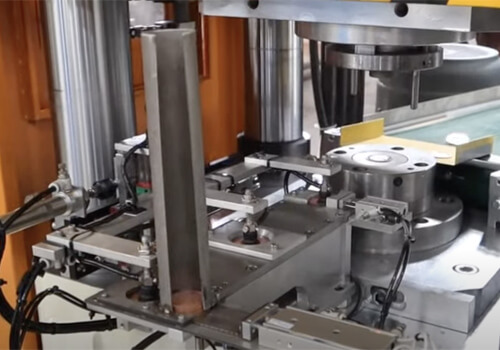Medal Die
SuperbMelt - World-Class Manufacturer of Medal Molds for Copper, Silver, Gold, and More


SuperbMelt Medal Die is used for shaping and producing medals and badges. These dies are made from sturdy materials such as metal or hard alloys and are customized to specific shapes and sizes according to the designer’s requirements. The purpose of the Medal Die is to impart a unique appearance, shape, and pattern to the medals during the manufacturing process, ensuring the final products meet the design specifications.
These dies can produce various types of medals, including gold, silver, bronze, and other Medal Dies. Each die contributes to the creation of unique and market-demanding medal pieces.
SuperbMelt’s Medal Die is installed on a hydraulic press, aiding medal or badge manufacturers in achieving rapid and bulk production to meet market demands.
- Excellent Durability: Made of sturdy metal or hard alloy components, this die ensures extended usage at high strengths, extending its longevity.
- Customization: Dies may be made to fit the exact specifications of the designer, allowing for a wider range of designs and forms to be produced in medals and offering more creative freedom.
- Precision: Provides exceptional precision in the designs and forms of medals, guaranteeing uniformity and excellence in every medal manufactured.
- Versatility: Adaptable to several medal kinds, including bronze, silver, and gold, satisfying a range of consumer needs.
- Effective Manufacturing: Mounted atop a hydraulic press, allowing for quick and large-scale manufacturing, improving production effectiveness.
- Creative Design: Encourages creative and detailed designs that give the medals a distinctive look and form.
- Market Adaptability: Fulfills the makers of medals and badges’ need for quick batch manufacturing while adjusting to shifting consumer preferences.
- Sports Events: For the purpose of rewarding victors and competitors, gold, silver, bronze, and other medals are manufactured.
- Military Commendation: Used to make badges and medals for the police, military, or other military groups to honor people for their valiant deeds and exceptional service.
- business Recognition: Adaptable to specific business functions, yearly awards ceremonies, etc., to honor exceptional workers and group accomplishments.
- Academic Achievements: Used to apply for scholarships, rewards for academic excellence, and other medals given out by colleges, universities, or other academic establishments.
- Cultural Arts: Used to honor exceptional artists, performers, or cultural contributions; applicable to the domains of the creative, performing, and cultural arts.
- Charity Events: Used to honor volunteers and supporters, charity events are held by social groups, charities, etc.
Why SuperbMelt Medal Die



Any Question About SuperbMelt Medal Die
FAQ Guide of Medal Die
- 1. What is a diecast Medal?
- 2. What are sports medals made of?
- 3. How many types of medals are there?
- 4. How are medallions made?
- 5. What is a custom medallion?
- 6. What is a Medal Die?
- 7. How is a Medal Die Created?
- 8. What Materials are Used for Medal Dies?
- 9. What is the Purpose of a Medal Die?
- 10. Can Medal Dies be Customized?
- 11. How Long Does it Take to Create a Medal Die?
- 12. Are Medal Dies Reusable?
- 13. Can Medal Dies be Used for Different Medal Types?
1. What is a diecast Medal?
A medal that is produced by the die casting method is referred to as a die-cast medal. Melted metal is forced under intense pressure into a mold cavity during the die casting process. Usually constructed of steel, the mold, also known as a die, is used to generate the appropriate shape and design of the medal.
The following steps are included in the die casting process for medals:
- Die preparation involves creating two steel molds, one for each side of the medal. These molds are made to exactly suit one another.
- Injection of Molten Metal: Under intense pressure, molten metal—typically an alloy like zinc—is poured into the mold. By filling the mold to the brim, the pressure ensures that all of the design’s minute features are captured by the metal.
- Cooling and Solidification: Within the mold cavity, the molten metal rapidly cools and solidifies, taking on the shape of the mold.
- Ejection: The newly produced die-cast medal is expelled when the mold’s two halves are split.
- Finishing: To attain the intended look, the die-cast medal may go through a number of finishing procedures, including painting, plating, and polishing.
Die-cast medals are a popular option for a variety of prizes, contests, and commemorative events because of their accuracy and exquisite craftsmanship. Zinc alloys are frequently used in die casting because of their advantageous casting qualities and capacity to produce a variety of finishes, including bronze, silver, and gold.
2. What are sports medals made of?
Sports medals are usually constructed of a variety of materials, the selection of which is based on a number of criteria, including the event’s level of status, budget, and design preferences. The primary components of sports medals consist of:
- Metal Alloys: Metal alloys like bronze, silver, or gold alloys are used to make a lot of sports medals. While silver and gold are typically chosen for second and first place medals, bronze is a common option for third place medals. These alloys frequently include copper, zinc, and other metals in combination.
- Die-cast zinc is a reasonably priced substitute for conventional metal alloys. To make die-cast zinc medals look like more expensive metals, they can be finished with gold, silver, or bronze plating.
- Plastic: Medals made of plastic are sometimes possible, particularly for junior sports or events with limited funding. To make them resemble conventional medals, metallic coatings are frequently applied to them.
- Acrylic: Medals made of acrylic have a sleek, contemporary appearance. They are frequently laser-cut or engraved with event details, and they can be translucent or colored.
- Wooden medals are an eco-friendly and distinctive choice. Logos and event details can be printed or etched on them.
- Resin: Medals made of resin are adaptable and may be shaped into a wide range of patterns and forms. They are frequently employed in unique or creative medal designs.
3. How many types of medals are there?
Medals come in a variety of forms that are intended to honor contributions, successes, and accomplishments across a range of industries.
- Sports medals: Given out for success in sporting events, competitions, or tournaments. They frequently have gold, silver, and bronze hues to signify varying ranks.
- Military Medals: Honor duty, gallantry, and bravery in the armed forces. Campaign medals, service medals, and medals for particular bravery might be among them.
- Awarded for exceptional service and achievements to society in non-military circumstances, such as public service or humanitarian endeavors, are the Civilian Service Medals.
- intellectual Medals: Awarded by educational institutions for distinction in research, study, or particular areas, these medals honor intellectual accomplishments.
- Arts and Culture Medals: Awarded for achievements in writing, music, painting, or other forms of cultural contribution. Awards for exceptional performances, works of art, or contributions to cultural heritage may be among them.
- Medals for Science and Technology: Given in recognition of noteworthy achievements to the fields of science and technology. They are able to identify breakthroughs, innovations, and inventions.
- Commemorative medals: Given out to commemorate important occasions, anniversaries, or turning points in history. They might be given out to attendees or those connected to the event.
- Award exceptional accomplishments in a variety of domains, such as business, industry, or personal achievements, with achievement medals.
- Medals for bravery or valor: Given for courageous, heroic, or valiant deeds in the face of peril. These are frequently delivered in formal or informal settings.
- Medals for Long Service: Given for devoted and sustained work in a certain industry, sector, or organization.
- Specialized Recognition Medals: Designed to honor industry leaders or specialized causes, including environmental preservation, humanitarian work, or outstanding achievement in a particular profession.
- Custom medals are made to order for certain occasions, groups, or people. They are frequently made to symbolize particular themes, emblems, or logos.
4. How are medallions made?
Medals are cast by SuperbMelt using molds on an automated hydraulic press.
Several crucial phases are included in the production process:
Creating the Medallion
First comes the design process, in which a precise and intricate design is developed using text, images, and other components pertinent to the medallion’s intended use.
Making a Die
The pattern is impressed or struck onto the medallion’s surface using a specially made die. Using engraving or etching procedures, the pattern is transferred to a metal die, usually composed of steel.
Setting Up the Blank
Blanks made of the medallion’s material—typically metals like bronze, silver, or gold—are produced. Usually, these blanks are spherical discs with the appropriate thickness and dimension.
A blow to the medallion
The technique known as minting involves using the prepared die to strike the pattern onto the blanks. This is frequently accomplished by imprinting the pattern into the blank using a coining press, which exerts significant pressure to create raised and recessed elements.
Completing
The medallion goes through a number of finishing procedures once it is struck. To get the intended final aesthetic, this may entail polishing to improve appearance, adding patinas or coatings for colors, and performing further treatments.
Quality Assurance
Strict quality control procedures are used all along the way to guarantee that every medallion fulfills the required requirements. This include checking for flaws, confirming the design’s correctness, and guaranteeing the materials’ quality.
Distribution and Packaging
Medallions are packed for delivery after passing quality control inspection. The medallion may be presented in a case or box with related documents or accessories, depending on its intended use.
5. What is a custom medallion?
A bespoke medallion is a uniquely created medal that has been particularly designed and produced to meet specific criteria. Custom medallions are made with unique designs, as opposed to regular or mass-produced medals, and sometimes include personalized components like names, brands, dates, and particular imagery appropriate for the event or goal.
Custom medallions have several important characteristics, such as:
- Personalization: Custom medallions are made in accordance with the client’s requirements and preferences. This might entail adding original text, graphics, or symbols that have symbolic or personal meaning.
- Distinctive Designs: Every personalized medallion is intended to be unique. Designers collaborate closely with customers to produce a unique and significant artwork that fits the intended use, be it special occasions, awards, or commemorations.
- Material Options: For their personalized medallions, customers may frequently select from a variety of metals, including bronze, silver, gold, and others. The medallion’s look, price, and perceived worth can all be influenced by the material selection.
- Event-Specific Components: Custom medallions are frequently made in honor of certain occasions, milestones, or accomplishments. This makes it possible to incorporate components into the medallion that appropriately capture the essence and importance of the occasion, turning it into a keepsake.
- Excellent craftsmanship: Because bespoke medallions are made to order, they are usually made with great care and attention to detail. To guarantee that the finished product fulfills the expectations of the customer, skilled artisans and craftsmen are involved in the production process.
- Versatility: Personalized medallions may be used for a number of things, such as promotions, awards, recognitions, and commemorations. Their designs are adaptable to many situations and offer versatility.
- Presentation and packaging: To improve their appearance, custom medallions are sometimes displayed in display cases or unique packaging. This raises the personalized piece’s overall value and attractiveness.
Custom medallions offer an important and unique way to commemorate and show gratitude, whether they are used for acknowledging accomplishments, honoring people, or marking noteworthy occasions.
6. What is a Medal Die?
A medal die is a specialized tool used in the minting process to strike or impress a design onto a blank, creating a medal. It is typically made of durable materials like steel and is crucial for achieving the desired design on the medal’s surface.
7. How is a Medal Die Created?
Medal dies are created through engraving or etching techniques. Skilled artisans transfer the detailed design onto a metal die, ensuring precision and accuracy in reproducing the intended imagery on the medals.
8. What Materials are Used for Medal Dies?
Medal dies are commonly made of high-quality steel due to its durability and ability to withstand the pressure applied during the striking process. The choice of materials ensures longevity and consistency in the die’s performance.
9. What is the Purpose of a Medal Die?
The primary purpose of a medal die is to impart a specific design onto a blank, shaping and defining the features of the resulting medal. It plays a crucial role in the minting process, influencing the medal’s appearance, details, and overall quality.
10. Can Medal Dies be Customized?
Yes, medal dies can be customized to accommodate unique designs, logos, text, or other personalized elements. Customization allows for the creation of distinct and one-of-a-kind medals tailored to specific events or occasions.
11. How Long Does it Take to Create a Medal Die?
The time required to create a medal die depends on factors such as the complexity of the design and the chosen manufacturing techniques. Generally, the process involves careful planning and craftsmanship to ensure precision.
12. Are Medal Dies Reusable?
Medal dies are durable and can be used for a significant number of strikes, but their lifespan depends on factors like design intricacy, materials used, and the striking force applied. Regular maintenance and occasional refurbishment can extend their usability.
13. Can Medal Dies be Used for Different Medal Types?
Yes, medal dies can be versatile and used for various types of medals, including gold, silver, bronze, and other materials. The adaptability of medal dies allows for flexibility in creating a diverse range of medals for different purposes.


 © Copyright 2008-2021 Superb Electromachinery Co., Limited
© Copyright 2008-2021 Superb Electromachinery Co., Limited